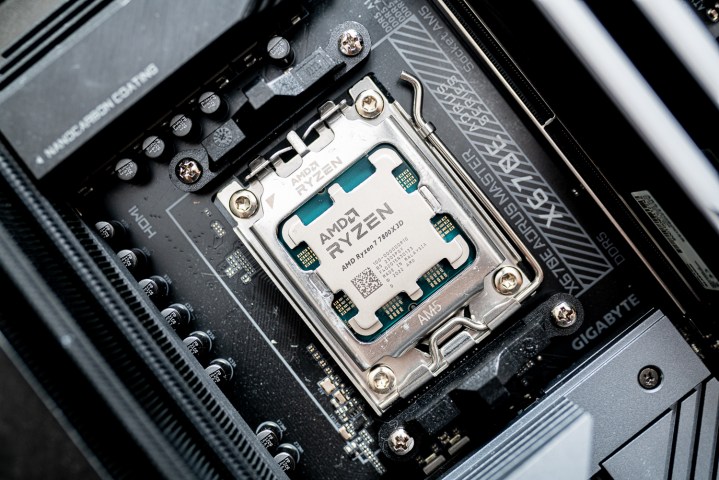Nvidia makes some of the best graphics cards, but most of them are ridiculously expensive. In fact, some of them are so pricey that you could build a whole gaming PC for the price of one GPU. This is where AMD has an edge — it doesn’t just have more affordable graphics cards, but it also makes processors to match.
By choosing AMD, you might be able to get more bang for your buck than if you were to pick an Intel CPU and an Nvidia GPU. So I did it, picking out all the components for a build you could go out and build today for the price of a single GPU.
Why AMD is a better choice

Now that both AMD and Nvidia have plenty of hardware up for grabs, it’s a good time to build a PC. Both manufacturers have seen some hefty price cuts on their GPUs, and AMD CPUs are cheaper than ever. However, including Nvidia and/or Intel in your build almost always means having to pay more. If you just want a PC that can play AAA games, that’s not always going to be a necessity.
Just a few months ago, things weren’t so simple. AMD’s graphics lineup was pretty bare, with only the flagship RX 7900 XTX and RX 7900 XT, as well as the budget RX 7600. When building a PC for 1440p, you’d be restricted to one of the top cards or to an older RDNA 2 GPU. Now, with the RX 7800 XT and RX 7700 XT finally here, AMD GPUs can fit into any PC build, regardless of your budget.
Nvidia GPUs have one edge over AMD — they have Deep Learning Super Sampling (DLSS 3). While on paper AMD is often around the same level, Nvidia’s frame generation can boost the RTX 4070 to run faster than an RTX 4090, and that’s saying something. However nice DLSS 3 is, it might not be worth going over budget for; it’s not available in that many games, and many people hardly ever use it. If you’re willing to forego buying Nvidia and put up with the lack of DLSS and inferior ray tracing — which, let’s be real, is not a necessity for most gamers — then you can save a lot of money by going down the AMD route.

While it’s hard to deny that Nvidia still dominates the GPU sphere, AMD is doing far better in its battle against Intel. In an AMD versus Intel scenario, I would recommend using an AMD CPU for gaming almost every time. Intel processors, be it the 13th generation or its recent 14th-gen refresh, are often better for productivity. Thanks to the increase in core counts, your PC is simply more versatile with Intel.
If you’re into streaming or content creation, Intel is often considered a must. However, if you’re mostly using your PC for games, even if that means simultaneously watching a Twitch stream or using Discord, you’ll be just fine with AMD. The increase in L3 cache versus Intel options has been proven to work time and time again, which is why AMD now makes the best processors for gaming.
Performance aside, money is always a factor. Nvidia’s top-tier GPU has been getting pricier lately, so the RTX 4090 would cost you around $1,700 or more right now. Even the terrible-value RTX 4080 is around $1,050 to $1,100. With a budget that falls in that range, you can already get yourself a solid gaming PC for the price of a single Nvidia graphics card.
Here’s one such build, along with ideas on how to modify it to fit your needs and your budget.
Your AMD gaming PC under $1,500
| Component | Price | |
| CPU | $238 | |
| GPU | $520 | |
| Cooling | $75 | |
| Motherboard | $190 | |
| Memory | $100 | |
| Storage | $45 | |
| Case | $105 | |
| Power supply | $90 | |
| Total | $1,365 |
Here it is — a PC build that falls right between the price of the RTX 4080 and the RTX 4090. At $1,365, you’re getting a midrange PC suited for gaming at 1440p. Let’s go over the components and any potential changes you could make in this build.
CPU
For starters, the CPU. At this budget, the Ryzen 5 7600X is a solid choice for gaming purposes. It only has six cores, but it’s an affordable CPU that can hit clock speeds reaching up to 5.3GHz in boost mode, and that’s on top of a 4.7GHz base clock. More importantly, it belongs to AMD’s AM5 platform, which means future-proofing, as AMD will keep supporting this platform until at least the end of 2025.
What upgrades could you make? You could swap to the next CPU in line, meaning the Ryzen 7 7700 or 7700X, but that’s going to cost you extra (up to $310). At that stage, you could spend even more and get the $370 Ryzen 7 7800X3D, which is the fastest CPU for gaming right now. However, these upgrades will require further changes to the build. The Ryzen 7 7700X should be fine with the Be Quiet! cooler I picked out here, but for the 7800X3D, I’d recommend a liquid cooler, as it can run pretty hot. The will fit this case and barely ups the cost of the build, although, of course, better all-in-one (AIO) coolers also exist.
If you want to save a few dollars, you can swap the CPU out for the Ryzen 5 7600. It has slightly lower clock speeds, but it’s more power efficient and generates less heat.
GPU
AMD’s recent RX 7800 XT is a logical choice for any build at this price point right now. Although it’s not significantly faster than its predecessor, it costs about the same and is a current-gen card. The is a cheaper alternative, but due to its performance-to-price ratio, it’s just not as good a deal as the RX 7800 XT.
For savings, there’s always the , which will mark a downgrade in performance, but it’ll save you $100 to $120. If you want something better, the is an option at around $610. In that case, though, you should upgrade the power supply to a 750-watt model (or higher), such as the .
Memory and storage
Using a Ryzen 7000 processor locks you to DDR5 RAM, which makes it a pricier affair, but is also better for future upgrades. I chose a middle-of-the-road kind of kit for this build, although it’s definitely one of the best DDR5 RAM kits on a budget, and it supports AMD EXPO profiles. You could pick something cheaper, but you could also pick something much more expensive with a higher frequency and better timings. Ultimately, it’s not going to make or break your gaming experience, so it’s an easy expense to pass on.
The same goes for the SSD. I decided to forego adding an HDD to this build, but if you need one, there’s plenty of room for extra storage. The SSD could also be upgraded to a 2TB model, and there are faster SSDs out there if you’re willing to spend more money — but be prepared to pay twice as much or more. The is a much pricier pick that’s better across the board.
Motherboard, PSU, and case
While this Gigabyte B650 Gaming X AX is not the cheapest AM5 board you’ll find, it’s often a good idea to allocate a little bit more of your budget toward the motherboard — after all, it’s the spine of your computer. This model is one of the best motherboards at this price range, with a decent VRM and plenty of slots, not to mention Wi-Fi. In all honesty, I wouldn’t change it out for anything here, although the or the are similar options to consider.
As far as the PSU goes, the Seasonic 80+ Gold is a decent option for this build without any upgrades, and will still suffice if you upgrade the CPU as well as a couple of smaller components. It has enough headroom to be just fine with that. However, if you decide to make bigger changes, make sure to pick up a 750W or even 850W option for future-proofing (although that’s pretty overkill). Choose either an 80+ Gold or Platinum PSU, not Bronze, like the I recommended above.
Buying a PC case for any build is always tricky, because it’s not just about airflow and whether everything fits, but also the aesthetic. I picked the Lian Li Lancool 216 because it has two massive 200mm fans and plenty of airflow, but let me warn you — that airflow stems from the fact that it’s pretty huge. This one also comes in white if you prefer that aesthetic. If you plan on making any changes to the case, check out our lineup of the best PC cases and be very, very careful to make sure all the components will fit inside.
You don’t have to spend too much

The PC gaming world thrives on marketing. We’re always told that this or that new component is the fastest ever, or that it will deliver some kind of insane performance in games. The truth is that a PC is nothing more than a sum of its parts, and if you’re on a tight budget, it makes no sense to spend $1,000 to $1,700 or more of that budget on the graphics card alone. Most users really don’t need that kind of firepower.
Sure, buying a high-end Nvidia GPU would let your computer breeze through 4K, whereas the computer above is more of a 1440p build. Even so, this is a PC that will last you years and will play games on high to ultra settings. For gaming and gaming alone, it’s cost-effective — and the fact that it still costs just $200 more than the RTX 4080 says a lot about Nvidia’s pricing strategy in this generation. After all, the last-gen RTX 3080 launched with a $700 price tag. If the prices stayed the same, the scales might have tipped more in Nvidia’s favor this time around, too.
Editors' Recommendations
- Hyte made me fall in love with my gaming PC all over again
- All of the exciting new GPUs still coming in 2024
- These 5 PC upgrades are the biggest money wasters
- GPU prices are back on the rise again
- New Nvidia update suggests DLSS 4.0 is closer than we thought





